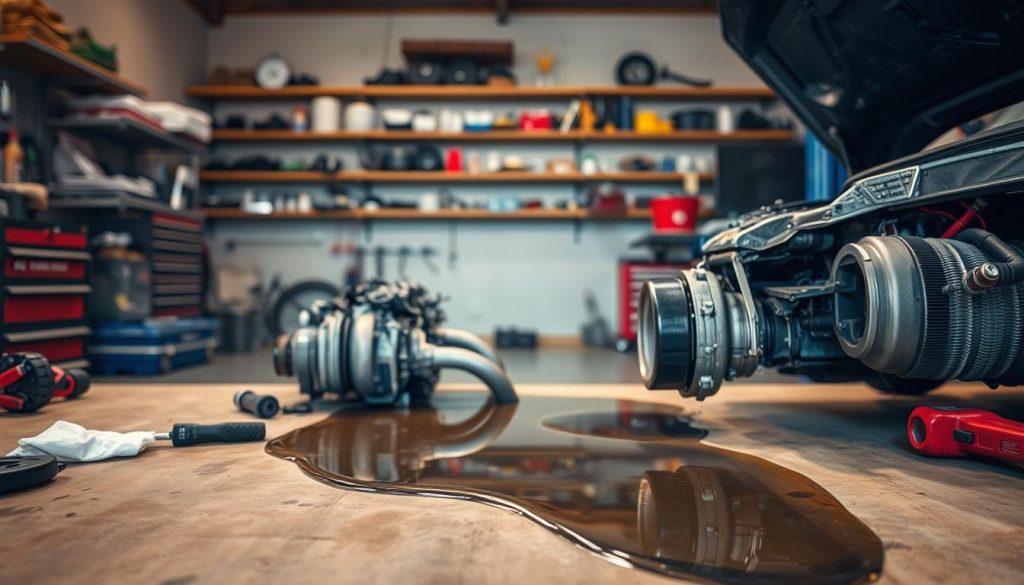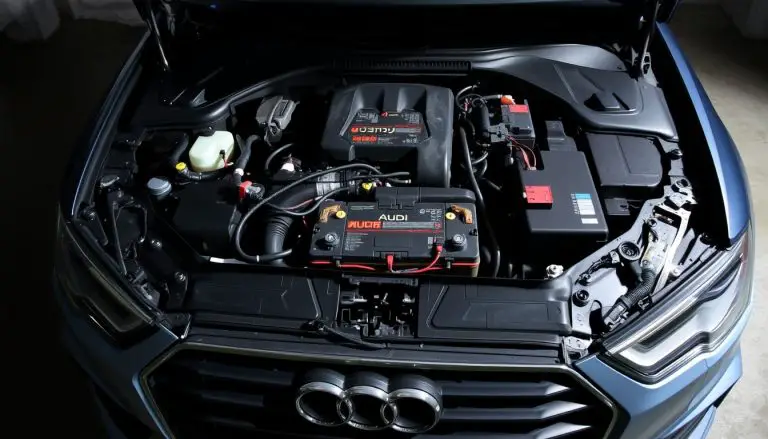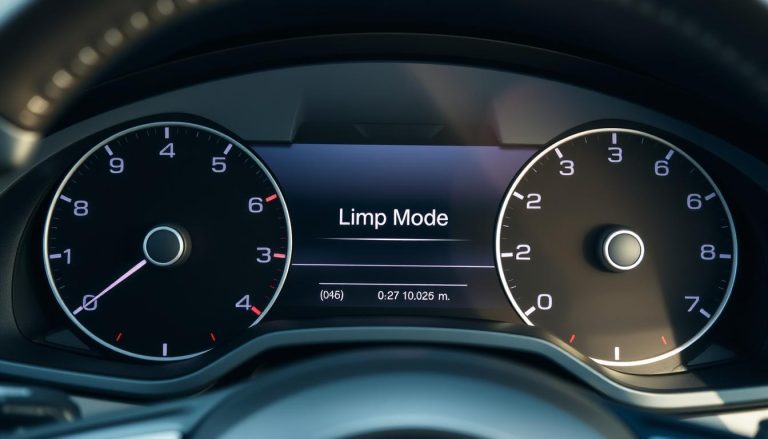Experiencing a coolant leak in your Audi can be concerning, especially when the engine isn’t overheating. This issue can be puzzling for car owners, as the symptoms don’t align with the typical signs of a coolant leak.
The presence of a coolant leak without overheating indicates a complex issue that requires a nuanced understanding of your vehicle’s cooling system. Various factors could be contributing to this problem, ranging from a faulty radiator or water pump to more subtle issues like a cracked head gasket or compromised coolant hoses.
Understanding the root cause is crucial for applying the correct fix and ensuring your Audi operates safely and efficiently.
Key Takeaways
- Identify the source of the coolant leak to apply the correct fix.
- Inspect the cooling system components for signs of damage or wear.
- Consider the role of the radiator, water pump, and head gasket in the issue.
- Check coolant hoses for any signs of compromise.
- Consult a professional mechanic if the issue persists or is unclear.
Understanding Coolant Leaks in Audi Vehicles
Understanding the cooling system in your Audi is essential for identifying and addressing coolant leaks. The cooling system is a critical component of your vehicle’s engine, and its proper functioning is vital for the longevity and performance of your Audi.
The Role of Coolant in Your Audi’s Engine System
Coolant, also known as antifreeze, circulates through the engine to absorb heat and transfer it to the radiator, where it’s dissipated. This process maintains the engine’s optimal operating temperature. Audi recommends using a specific type of coolant that meets their specifications to ensure compatibility and performance.
Why Coolant Leaks Don’t Always Cause Overheating
A coolant leak doesn’t immediately lead to overheating because modern Audi vehicles are equipped with sophisticated cooling systems and sensors that can compensate for minor leaks. However, ignoring a coolant leak can lead to serious engine damage over time.
Audi Coolant Specifications and Types
Audi specifies the use of coolant that meets G12 or G13 standards. The G13 coolant is a more advanced formulation that provides better corrosion protection and is compatible with a wider range of materials used in modern engines.
| Coolant Type | Specification | Compatibility |
|---|---|---|
| G12 | Meets Audi’s older specifications | Compatible with older Audi models |
| G13 | Meets Audi’s current specifications | Compatible with both older and newer Audi models |
Signs Your Audi is Leaking Coolant
Identifying a coolant leak in your Audi can be challenging, but there are several key signs to look out for. Recognizing these signs early can help prevent engine damage and costly repairs.
Visual Indicators of Coolant Leakage
One of the most obvious signs of a coolant leak is the presence of green or yellow fluid under your vehicle. Coolant can leak from various points in the cooling system, including the radiator, hoses, and water pump. Inspecting these areas regularly can help you catch a leak before it becomes a major issue.

Dashboard Warning Signs
Your Audi’s dashboard is equipped with warning lights that can indicate a coolant leak or low coolant level. If the coolant level falls below a certain threshold, the dashboard warning light will illuminate, signaling that you need to check the cooling system.
Performance Changes You Might Notice
A coolant leak can also affect your vehicle’s performance. You might notice temperature fluctuations, or the engine might run hotter than usual. In some cases, a coolant leak can lead to engine overheating, although this is not always the case.
Distinguishing Coolant Leaks from Other Fluid Leaks
It’s essential to distinguish coolant leaks from other types of fluid leaks, such as oil or brake fluid leaks. Coolant typically has a distinct green or yellow color, whereas engine oil is usually black or brown. Creating a simple table can help you differentiate between these fluids:
| Fluid Type | Color | Consistency |
|---|---|---|
| Coolant | Green or Yellow | Thin, watery |
| Engine Oil | Black or Brown | Thick, oily |
| Brake Fluid | Clear or Light Brown | Thin, oily |
By understanding these signs and being able to identify coolant leaks, you can take prompt action to repair your Audi and prevent further damage.
Audi Leaking Coolant but Not Overheating? Common Causes and Solutions
Audi owners often face a perplexing issue when their vehicle leaks coolant without showing signs of overheating. This phenomenon can be attributed to several factors, and understanding these causes is crucial for effective diagnosis and repair.
Damaged Radiator or Radiator Cap
A damaged radiator or a faulty radiator cap can lead to coolant leaks. Inspecting the radiator for any signs of damage or corrosion is essential. For more information on diagnosing coolant leaks, visit RepairPal.

Faulty Water Pump
A malfunctioning water pump can also cause coolant leaks. The water pump is a critical component of the cooling system, and its failure can lead to significant coolant loss.
Cracked Expansion Tank
The expansion tank is prone to cracking, especially in older Audi models. Inspecting the tank for any signs of damage is crucial.
Deteriorated Hoses and Connections
Over time, hoses and connections can deteriorate, leading to coolant leaks. Regular inspection can help identify these issues before they become major problems.
Head Gasket Issues
Head gasket problems can also cause coolant leaks. Diagnosing head gasket issues requires professional expertise and specialized tools.
Model-Specific Common Issues
Different Audi models have their unique common issues. For instance, the A4 and A6 models often experience issues with the radiator and water pump, while the Q5 may have problems with the expansion tank.
Understanding these common causes and solutions can help Audi owners diagnose and fix coolant leaks effectively. Regular maintenance and inspections are key to preventing these issues.
DIY Diagnosis: Locating the Source of Coolant Leaks
Locating the source of a coolant leak in your Audi requires a methodical DIY diagnosis. This process involves several steps that help you identify the leak’s origin, ensuring you can address the issue effectively.
Tools Needed for Proper Diagnosis
To start, you’ll need a few essential tools: a coolant pressure tester, UV dye, a black light, and a basic toolkit. The coolant pressure tester allows you to pressurize the cooling system, making leaks easier to detect. Understanding coolant leak fixes can also provide valuable insights into the diagnosis process.
Preparing Your Audi for Inspection
Before you begin, ensure your Audi is on a level surface and the engine is cool. Remove the radiator cap, and check the coolant level, topping it off if necessary. This preparation is crucial for an accurate diagnosis.
Step-by-Step Leak Detection Process
Visual Inspection Techniques
Start with a visual inspection of the cooling system components, looking for signs of leakage, such as drips or stains. Pay particular attention to areas around hoses, connections, and the radiator.
Pressure Testing the Cooling System
Use a coolant pressure tester to pressurize the system. Listen for the sound of escaping air or observe the pressure gauge for drops, indicating a leak.
Using UV Dye for Hidden Leaks
For leaks that are not immediately visible, add UV dye to the coolant. Then, use a black light to inspect the cooling system. The dye will highlight the leak’s location.
Common Leak Points in Audi Cooling Systems
Common areas for leaks include the radiator, water pump, hoses, and expansion tank. Being aware of these potential leak points can help guide your inspection.
How to Fix Common Audi Coolant Leaks
Coolant leaks are a common problem in Audi vehicles, but knowing how to fix them can save time and money. The process involves identifying the source of the leak and applying the appropriate repair. In this section, we will guide you through the steps to fix common coolant leaks in your Audi.
Replacing Damaged Hoses
One of the most common sources of coolant leaks is damaged or deteriorated hoses. Inspecting your Audi’s hoses regularly can help you identify potential issues before they become major problems. To replace a damaged hose, you’ll need to purchase a replacement that matches the original specifications.
Addressing Radiator Issues
The radiator is another critical component of your Audi’s cooling system that can be prone to leaks. Signs of a radiator leak include visible coolant around the radiator and a drop in coolant level. Repairing or replacing the radiator may be necessary, depending on the extent of the damage.
Repairing the Water Pump
A faulty water pump can also cause coolant leaks. If you notice coolant leaking from the water pump area, it may need to be replaced. Ensure you follow the manufacturer’s instructions for removing the old water pump and installing a new one.
Fixing Expansion Tank Problems
The expansion tank is another potential source of coolant leaks. Inspect the tank for cracks or damage and replace it if necessary. Properly securing the tank and its connections can prevent future leaks.
Using Coolant Stop-Leak Products: Pros and Cons
Coolant stop-leak products can be a temporary solution for small leaks, but they are not a permanent fix. It’s essential to weigh the pros and cons before using these products, as they can sometimes cause more harm than good.
Proper Coolant Refill and Bleeding Procedures
After repairing a coolant leak, it’s crucial to refill the coolant system with the correct type of coolant and bleed the system to remove any air pockets. Following the manufacturer’s guidelines for coolant refill and bleeding procedures will help ensure your Audi’s cooling system operates efficiently.
Preventative Maintenance to Avoid Future Coolant Leaks
Preventing coolant leaks is easier than fixing them; here’s how to maintain your Audi’s cooling system. Regular maintenance not only saves you from potential costly repairs but also ensures your vehicle runs efficiently.
Recommended Coolant Change Intervals
Audi recommends changing the coolant every 30,000 to 50,000 miles, depending on the model and year of your vehicle. It’s essential to consult your owner’s manual or speak with a certified Audi technician to determine the best schedule for your car.
Regular Cooling System Inspections
Regular inspections can help identify potential issues before they become major problems. Check the cooling system for signs of wear, such as cracks in the hoses, corrosion on the radiator, or leaks around the water pump.
Winter and Summer Maintenance Tips
During winter, ensure your coolant is rated for low temperatures to prevent freezing. In summer, check that the cooling system is functioning correctly to avoid overheating. Regularly inspect the coolant level and condition to ensure it’s doing its job.
Monitoring Coolant Levels and Quality
Regularly check the coolant level to ensure it’s at the recommended level. Also, inspect the coolant’s color and consistency; a dirty or contaminated coolant can indicate a problem within the cooling system.
By following these preventative maintenance tips, you can significantly reduce the risk of coolant leaks in your Audi, ensuring a longer lifespan for your vehicle’s engine.
Conclusion
Understanding the causes and solutions for Audi coolant leaks is crucial for maintaining the health of your vehicle’s cooling system. As discussed, a leaking coolant doesn’t always result in overheating, but it’s essential to address the issue promptly.
Common causes include damaged radiators, faulty water pumps, cracked expansion tanks, and deteriorated hoses. By identifying the source of the leak and applying the appropriate fix, you can prevent further damage to your Audi’s engine.
Regular maintenance, such as checking coolant levels and inspecting the cooling system, can help prevent future leaks. By staying proactive, you can ensure your Audi continues to run smoothly and efficiently, avoiding costly repairs down the line.
In conclusion, addressing an Audi coolant leak requires a comprehensive approach that includes diagnosis, repair, and preventative maintenance. By following the guidelines outlined in this article, you can effectively manage coolant leaks and maintain your vehicle’s performance.
FAQ
What are the common causes of Audi leaking coolant but not overheating?
Common causes include damaged radiators or radiator caps, faulty water pumps, cracked expansion tanks, deteriorated hoses and connections, and head gasket issues.
How can I identify a coolant leak in my Audi?
Look for visual indicators such as green or yellow fluid under the vehicle, dashboard warning signs like the coolant level warning light, and performance changes like decreased engine performance.
Can I drive my Audi if it’s leaking coolant?
It’s not recommended to drive your Audi if it’s leaking coolant, as this can cause damage to the engine and other components. However, if the leak is minor and the engine is not overheating, you may be able to drive it to a repair shop.
How do I diagnose a coolant leak in my Audi?
To diagnose a coolant leak, inspect the cooling system visually, use a pressure test kit to pressurize the system, or use UV dye to detect hidden leaks.
What is the recommended coolant type for my Audi?
The recommended coolant type for your Audi depends on the model and year. Check your owner’s manual or consult with a dealership or mechanic to determine the correct type.
Can I use a coolant stop-leak product to fix my Audi’s coolant leak?
Coolant stop-leak products can be used to temporarily fix minor coolant leaks, but they are not a permanent solution. It’s recommended to repair or replace the damaged component to prevent further issues.
How often should I change my Audi’s coolant?
The recommended coolant change interval varies depending on the Audi model and year. Typically, it’s recommended to change the coolant every 30,000 to 50,000 miles.
Can I perform preventative maintenance to avoid future coolant leaks?
Yes, regular cooling system inspections, monitoring coolant levels and quality, and following recommended coolant change intervals can help prevent future coolant leaks.


